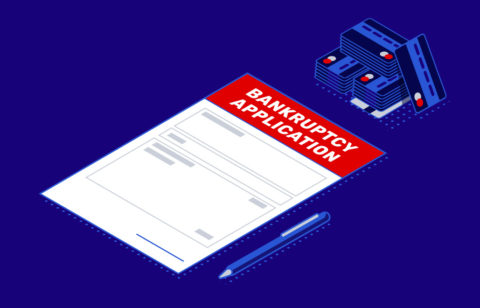If you landed on this page, you are probably wondering if bankruptcy is the best option for you to get rid of your debt. Truth be told, any financial expert will never suggest this as a first option. While it may seem like the easiest way out, the consequences and bad effects it would have on your credit history makes it not worthwhile in many circumstances.
Believe it or not, bankruptcy is actually guaranteed in the U.S. Constitution. Our founding fathers believed that everyone burdened with more debt than they could handle should be able to get a fresh start. The details of this are set out in the U.S. Bankruptcy Code, which has undergone various changes over the years. In 1934, it was designed to benefit debtors who admitted to the unfortunate events that made it impossible for them to repay their financial obligations. This was meant to give people a fresh start – to rebuild their losses and start anew – without the pressures of mounting debts and harassing creditors.
There are now six different parts to the U.S. Bankruptcy Code called chapters from which people and businesses can choose when declaring bankruptcy. The most recent changes to bankruptcy laws occurred in 2005. It was done as a response to the way people in debt reacted to the economic recession. Instead of just protecting debtors it was designed to protect both creditors and debtors.
Bankruptcy Basics
The country is divided into 90 bankruptcy districts. All 50 states have one – some more than one. A US bankruptcy judge presides over every case and delivers a final decision. These judges decide whether or not a debtor will be awarded a discharge of debt and the chapter that will be used to declare it. In most cases the debtor will not even meet with this judge. The only meeting a debtor might have in connection with his or her case is during what’s called a 341 meeting where the creditors will be allowed to question him or her. However, in practice 341 meetings are hardly ever held. As mentioned above, the Bankruptcy Code offers six different chapters from which individuals, organizations or groups can choose.
Chapter 11. Reorganization
People, companies and other organizations whose goal is to create a reorganization plan that’s then sanctioned by the bankruptcy court commonly choose this type of filing. The goal of this plan is to give debtors time to reorganize their finances in order to repay their creditors while still being able to pay their living expenses or continue their business operations. A debtor must provide a reorganization plan within 120 days after filing for bankruptcy. In the event the debtor is an individual he or she will also be responsible for providing a disclosure statement to the creditors so they will be able to evaluate the reorganization plan. In the event the bankruptcy judge approves the reorganization plan it will call for the repayment of only a percentage of the original balances while the other debts will be discharged.
Chapter 12. Adjustment of Debts of aFamily Farmer or Fisherman with Regular Annual Income
The name of this chapter is somewhat self-explanatory – at least for the people involved. Here, the debtor is asked to provide a plan that will include how he or she will pay off their debts through a payment schedule that cannot last for more than three years. The court does have the right to increase this term to five years if it agrees that the circumstances warrant it. The bankruptcy trustee will help disburse the payments to the creditors – in accordance with the court-approved plan. This arrangement allows the business to continue operating while making repayments.
Chapter 9. Adjustment of Debts of a Municipality
This type of bankruptcy is specific to cities, towns. municipalities and other forms such as villages, etc. It allows the filing party to file for reorganization. This means that with the court’s approval, it will be required to fulfill only a portion of its obligation to debtors while the remaining balance is stricken off the books.
Chapter 15. Ancillary and Other Cross-Border Cases
This type of bankruptcy directly deals with insolvency when it occurs beyond the borders of the United States. Its objective is to apply the bankruptcy laws of the US and the laws of foreign countries as needed. This gives the business entity filing for bankruptcy the opportunity to take advantage of both U.S. and country specific bankruptcy laws.
What are the Different Types Of Bankruptcy Laws That Would Affect You?
There are two types of bankruptcies available to individuals. They are a chapter 7 and a Chapter 13.
Types of bankruptciesAvailable to Individuals
Chapter 7. Liquidation
A chapter 7 bankruptcy’s goal is to liquidate all of the person’s assets to pay off his or her creditors. The court will assign a bankruptcy trustee to manage the liquidation of all available assets. This is to help the debtor liquidate all qualified assets and that everything is done under law-mandated procedures. If there are assets that can be liquidated the first creditors in line to get payments are secured creditors or those where some asset was used to collateralize the debt such as a house or automobile. However, most people who file for bankruptcy don’t have any assets that could be liquidated as there are two types of assets – exempt and not exempt.
Assets that are not exempt and that could be liquidated include:
- Collections of coins, stamps and other valuable items
- Costly musical instruments unless the debtor is actually a professional musician
- Cash, bank accounts, bonds, stocks and other investments
- A vacation or second home
- A second car or a second truck
Assets that are exempt and not subject to liquidation include:
- A portion of equity in the debtor’s home
- Motor vehicles, up to a certain value
- Reasonably necessary clothing
- Pensions
- Jewelry, up to a specified Value
- Household appliances
- A portion of unpaid but earned wages
- Tools of the debtor’s trade or profession, up to a certain value.
- Public benefits such as public assistance (welfare), social security, and unemployment compensation, accumulated in a bank account
- Damages awarded for personal injury
As you can see from this list the average person filing for a chapter 7 bankruptcy would have virtually all of his or her assets excluded so that there would be not much left to liquidate if anything. When this is the case and there are not enough assets to pay off a person’s lenders the court will discharge all those debts considered dischargeable. If you’re considering filing for bankruptcy it’s important to know that there are certain types of debts that won’t discharged. This includes:
- Child support and spousal maintenance (alimony).
- Most student loans, unless repayment would cause the debtor and his or her dependents undue hardship.
- Government-imposed restitution, fines, and penalties.
- Court fees.
- Debts resulting from personal injury damages or wrongful death damages to others from driving while intoxicated.
- Debts that were non-dischargeable in a prior bankruptcy
- Certain debts owed for condominium dues and fees
- Recent federal, state, and local taxes.Debts owed to certain pension plans
- Debts not dischargeable in a previous bankruptcy because of the debtor’s fraud.
There have been efforts to prevent the abuse of chapter 7 bankruptcies through amendments and by including a so-called “means test” for the debtor. This involves conducting a thorough investigation to determine if the income of the filing party, which is usually an individual, is in excess of certain benchmarks. If it is proven that the person’s income is above the benchmark, he or she may not be considered for Chapter 7 relief. Instead, that person will be moved to a chapter 13 bankruptcy. If the person filing for bankruptcy does qualify for a chapter 7 he or she will be required to get credit counseling from a credit counseling agency that’s approved by the US trustee’s office. This counseling must occur within 80 days before the person files for bankruptcy. When the counseling has been completed, a certificate of completion will be provided, which must be filed no later than 15 days after filing for bankruptcy. In the event that the person worked out a repayment plan with her or his lenders the agency will also provide a copy of it.
Chapter 13. Adjustment of Debts of an Individual with Regular Income
Anyone who is not permitted to file for bankruptcy under Chapter 7 will be directed to a Chapter 13. The previously mentioned “Means Test” refers to the measurement of a person’s income. If you have a regular source of income and it is within the middle- and high-income bracket, your unsecured debts will not be discharged immediately. The upside is that you will allowed to keep some of your valuable assets that would have been liquidated under a Chapter 7 bankruptcy.
The way a chapter 13 bankruptcy works is that you will develop a plan for repaying your debtors can that be anywhere from three to five years. This plan must be approved through the court and the bankruptcy judge. Whether or not it is approved will depend on if it meets the confirmation requirements as set out under the bankruptcy code. What this basically amounts to is that you must be able to prove to the bankruptcy court that you can afford to meet your payment obligations. If your income is too low or irregular you may not be allowed to file for a chapter 13 bankruptcy. And if your total debt burden is too high you would not be eligible. The benchmark is that your secured debts must not exceed $1,149,525 and your unsecured debts must not be more than $383,175.
The payment plan you develop must describe in detail how and how much you will pay each of your lenders. It must include the payment of certain debts in full. These are called priority debts because they’re important enough to jump to the start of the bankruptcy repayment line. Child support, alimony, wages you owe employees and certain tax obligations are considered to be priority debts. Plus, you must include in your plan regular payments on your secured debts which would include car loans or mortgage as well as the repayment of any amounts that you’re behind in your payments. Finally, your plan must show that after making your required payments you have some disposable income left over it must go towards repaying your unsecured debts such as medical bills and credit card debts. While you won’t be required to pay all of these debts in full (or even at all in some instances) you must be able to show that you’re using any remaining income to repay them.





